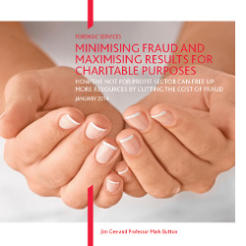Fraud in the large charity sector costs £1.65bn a year, according to a report published today by accountants BDO and the Centre for Counter Fraud Studies in Portsmouth.
The report, entitled Minimising Fraud and Maximising Results for Charitable Purposes, uses a global database collected by the centre, which shows that fraud accounts for 5.47 per cent of turnover, and applies this figure to the total income of 842 charities with incomes over £10m.
Jim Gee, director of counter-fraud services at BDO and one of the report’s authors, said that using the university’s global database produced a more accurate figure than relying on figures which showed reported fraud.
“Only around a thirtieth of fraud is detected,” he said. “Detected fraud is not an accurate estimate of the total cost.”
Gee said the figure was likely to be an underestimate for the whole sector, because it only referred to large charities, and because it did not take into account charities’ ability to prevent fraud, which may be lower than other sectors.
“There is a government-accepted measure of fraud resilience, and the charity sector averages 26 on that scale,” he said. “The public sector scores 34 and the private sector 30.”
He said his report focused only on larger charities because smaller organisations tended to face “a different set of problems”.
Gee said that fraud in the sector was carried out both by individuals within charities and those outside who fundraised in the name of a charitable organisation but did not pass on the money.
“The high-value, low-volume fraud is what hits the headlines,” he said. “But most fraud is high-volume and low-value. It’s people adding hours to their timesheet and items to their expenses, and taking home office equipment.
He said charities ought to protect against both because the low-value fraud costs the most, but high-value fraud can damage reputation.
He said that fraud could be reduced by up to 40 per cent by changes in culture, more deterrents for fraudsters, and improved design of anti-fraud measures.
“A lot of it comes down to soft skills,” he says. “It’s about better communication with the honest majority to create an anti-fraud culture, and with fraudsters to make it clear that they will be detected and face sanctions. A fraudster will make a risk assessment about the risks and benefits, and we need them to decide that the benefits are not worthwhile.”









